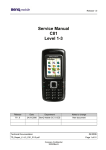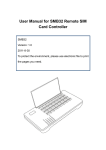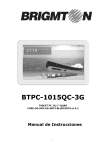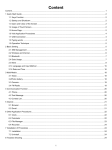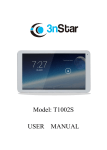Download STD47 1.0 – Simple Telemetry Application Owner`s Manual
Transcript
STD47 1.0 – Simple Telemetry Application Owner’s Manual STD47 – Simple Telemetry Application Owner’s Manual CEP AG Table of Content 1. 2. Safety Information ............................................................................................... 4 Main Functions: ................................................................................................... 5 2.1. Start-Up alarm message .............................................................................. 5 2.2. Digital Output control:................................................................................... 5 2.3. Digital Input event:........................................................................................ 5 3. Setup of the STD47 ............................................................................................. 6 3.1. General ........................................................................................................ 6 3.2. Setup of the GSM SIM-card for the STD47 .................................................. 6 3.3. Setup of the STD47...................................................................................... 7 3.3.1. Quick configuration call ......................................................................... 7 3.3.2. Resetting the STD47 to “factory setting” ............................................... 8 3.3.3. Expert configuration SMS ..................................................................... 8 4. Operating the STD47......................................................................................... 13 5. Trouble Shooting ............................................................................................... 14 6. Sample Applications .......................................................................................... 16 6.1. GSM Alarm Adaptor for Burglar Alarm System .......................................... 16 6.2. GSM remote control for garage door opener.............................................. 17 6.3. GSM remote sensing of a “door-open-/tampering-switch”.......................... 19 7. Technical Data .................................................................................................. 21 7.1. Mechanical Interface .................................................................................. 21 7.1.1. Overview ............................................................................................. 21 7.1.2. Physical Dimensions ........................................................................... 22 7.2. Electrical Interface...................................................................................... 23 7.2.1. Block diagram ..................................................................................... 23 7.2.2. RJ11 Connector Interface ................................................................... 24 7.2.3. DB15 Connector Interface................................................................... 25 7.3. Miscellaneous ............................................................................................ 27 8. Accessories ....................................................................................................... 28 8.1. Mains Power Adapter 220V........................................................................ 28 8.2. DC Power Cable......................................................................................... 29 8.3. GSM Dual Band Antenna ........................................................................... 29 8.4. GSM Dual Band Antenna with direct connection........................................ 30 Abbreviations............................................................................................................ 31 Aug/21/2003 Owner’s Manual Page 2 of 31 STD47 – Simple Telemetry Application Owner’s Manual CEP AG Introduction The STD47 is a simple telemetry solution for remote control and remote sensing of digital signals via GSM. This user manual is focusing in the functionality and the possible applications of the STD47. Depending on the accessories included in the package (e.g. power supply adaptor, GSM antenna, signal cable) normally no additional parts are necessary to operate the STD47, besides a valid SIM-card. If you want to step directly into the realisation of an application, please refer to chapter 6 Sample Applications. The STD47 is a CEP AG application, based on SonyEricsson GT47 hardware, extended by CEP AG SW to perform telemetry applications. After a simple and quick configuration procedure the STD47 allows you to control various devices and applications remotely by your GSM phone and you are able to receive messages and alarms from your devices and applications. The STD47 identifies and authorizes your GSM phone by its telephone number (CLIP function: Calling Line Identification Presentation). Configuration can be done in 2 ways: • quick configuration call: The “out-of-the-box” STD47 “learns” by a simple telephone call from a GSM phone to which telephone (number) it shall report and from which telephone (number) it can be controlled. • expert configuration SMS: The configuration is done by sending an SMS containing the configuration data as specified below. Aug/21/2003 Owner’s Manual Page 3 of 31 STD47 – Simple Telemetry Application Owner’s Manual CEP AG 1. Safety Information • The STD47 should be installed and set up only by qualified personnel. • Connect a DC supply voltage in the range of 5 – 32 V to the STD47. The voltage supply must be secured by a fast 1.25 A fuse. Insert a fast 1.25 A fuse into the wire for the positive supply voltage to protect the STD47, if you connect the STD47 directly to 5 – 32 V DC. • If a power supply unit is used to supply the STD47 device, it must meet the demands placed on SELV circuits (Safety Extra Low Voltage) in accordance with EN60950. When using batteries and accumulators, adhere to the relevant regulations. • The maximum permissible connection length between the STD47 and its peripherals is 3m. • Never expose the STD47 to excessive humidity, rain, water, acids etc. • Use the STD47 indoors only. • Never connect any voltage above 32 V to the STD47 and assure correct polarity. • Please note that apart from correct setup and correct installation, the STD47 depends always on the availability of a GSM network to operate correctly. Aug/21/2003 Owner’s Manual Page 4 of 31 STD47 – Simple Telemetry Application Owner’s Manual CEP AG 2. Main Functions: If set up accordingly, the STD47 will perform the following three main functions: 2.1. Start-Up alarm message Upon power-up, the STD47 will send an SMS to the configured numbers. The SMS may contain a default text (if the device was configured by a Quick configuration call (3.3.1)) or a user-defined text (if the device was configured by an Expert configuration SMS (3.3.3)). This function is especially handy, since an alarm condition can be signaled via GSM simply by applying power to the STD47, e.g. if the STD47 is connected in parallel to a siren or a flashlight, it will transmit alarm SMS whenever the siren or the flashlight are activated. 2.2. Digital Output control: Upon incoming calls from phones with configured telephone number(s), it will operate the output switches (OUT-1 and OUT-2 on the RJ11 connector and OUT-4 on the DB15 connector) connected to the signal cables. The incoming call will not be accepted by the STD47 (it remains “ringing”) and will be rejected by the STD47 after approx. 3 sec. No voice connection or valid call will be established. So this function will be free of charge for the user. 2.3. Digital Input event: Upon applying the supply voltage to the digital inputs (IN-1 on RJ11 connector and IN-2 on DB15 connector) for at least 1 second (default) a SMS will be send to the configured master-number. The SMS may contain a default text if the device was configured by a Quick configuration call (3.3.1) or a user-defined text if the device was configured by an Expert configuration SMS (3.3.3). All inputs are pulled to ground with a 40k resistor. If an input was configured as inverted input by an Expert configuration SMS (3.3.3), the inputs must be connected to the supply voltage. In case of an event, the connection to the supply voltage must be opened for at least 1 second (default). The duration the inputs must be switched (default value 1 second) to generate a SMS can be configured by an expert configuration SMS. Aug/21/2003 Owner’s Manual Page 5 of 31 STD47 – Simple Telemetry Application Owner’s Manual CEP AG 3. Setup of the STD47 3.1. General The STD47 recognizes the GSM phone you want to use to control it by its telephone number (CLIP function). Therefore it is necessary that you don’t suppress the transmission of your telephone number. Please make sure your GSM phone is not set to “incognito” or “suppress own telephone number” when controlling or configuring the STD47. To test this, simply make a phone call from your GSM phone to a friend’s phone. If he can see your telephone number in the display of his phone, everything is fine. 3.2. Setup of the GSM SIM-card for the STD47 It is recommended to use a SIM-card that needs no PIN-entry, in that case no further actions are required. If a SIM-card is used, that needs a PIN-entry before registering in the GSM-network, this function should be deactivated (not possible with some SIM-cards) alternatively the PIN can be set to “0000” (possible with all SIM- cards). This can be done e.g. with a normal GSM phone. Please refer to the owner’s manual of the used GSM phone. If the SIM-card is not configured this way, the STD47 can not register in the GSM network and will therefore switch off approx. 10 – 20 seconds after power-up. Please insert the SIM-card in the STD47 only after setup of the SIM-card as shown above! If the SIM-card PIN is not disabled, the STD47 will use “0000” as PIN. If this is not the correct SIM-PIN, it will result in a blocked SIM-card after the 3rd try. This process is comparable to entering the wrong PIN on your GSM phone 3 times. Such a SIM-card would need to be recovered by entering the “super-PIN” (or “PUK”) Aug/21/2003 Owner’s Manual Page 6 of 31 STD47 – Simple Telemetry Application Note: Owner’s Manual CEP AG It is recommended that you disable the voice-mailbox (and/or the diversion to it) for the SIM-card used in the STD47. 3.3. Setup of the STD47 The STD47 needs to know from which telephone it should accept commands and to which telephone it should report. This is called “configuration”. Note: • A “blank” STD47 without a valid configuration (= “factory setting”) will need a quick configuration call or an expert configuration SMS to know the GSM phone it reports to and it takes commands from. A “blank” STD47 without configuration data will switch off 3 minutes after power was applied. The green LED will be off then. Therefore the quick configuration call or the expert configuration SMS must be issued during the first 3 minutes after applying power. • All configuration data is stored on the SIM-card. Therefore, if you change the SIM-card of an STD47, the configuration procedure must be repeated. There are two ways to configure a STD47: 3.3.1. Quick configuration call The quick configuration can be used only if the STD47 is in factory settings state (taken right “out-of-the-box”) or after it has been reset to factory settings. The quick configuration is very easy: 1. Insert the correct configured SIM-card (see above), connect a GSM antenna and power up the STD47. 2. Wait for approx. 20 seconds to allow the STD47 to initialize for the first time and to register in the GSM network. 3. After that time the green LED should start flashing approx. once every 2 seconds – if not, please refer to the “trouble shooting section”. 4. Within the next 3 minutes, call the STD47 from the mobile phone that you want to use to control the device, and wait until the call is accepted. After these quick configuration steps the STD47 is configured with the masternumber, which is stored in the SIM-phonebook at the first entry. From now on, the start-up SMS and the event SMS will be sent to the mobile phone with the master-number. The STD47 will react on calls (to control the outputs) only from phones with either the master-number or phones with client-numbers (at positions 9 – 60 in the SIM phonebook). All alarm-numbers (phonebook entries 2-5) are deleted during the quick Aug/21/2003 Owner’s Manual Page 7 of 31 STD47 – Simple Telemetry Application Owner’s Manual CEP AG configuration pocedure. Please refer to chapter 3.3.3 Expert configuration SMS for more detailed information about master- alarm- and client-numbers. After the quick configuration the STD47 must be restarted, so that the SIM-telephone book entries with the actual configuration can be read. The SMS will be sent with the default text “START-UP ALARM” and “EVENT ALARM 1” or “EVENT ALARM 2” for the respective conditions. Note: • Unlike in any other operating condition, the STD47 will accept this first call and hang up after a few seconds. This function will show you that the STD47 has accepted the configuration call. • To repeat this quick configuration process with an already configured STD47, it needs to be reset to factory setting again. Please refer to section 3.3.2 Resetting the STD47 to “factory setting” below. • The length of an input pulse and output pulse is set to 1 sec per default. If you require other pulse timings, please use the 3.3.3 Expert configuration SMS below. 3.3.2. Resetting the STD47 to “factory setting” Resetting the STD47 to its “factory setting” is necessary if you want to delete the existing configuration data, e.g. because you want to repeat the quick configuration procedure again or you want to configure another mobile phone as master. There are two ways to reset an STD47 to factory setting: • Delete the SIM-card phone book entries (at least #1 to #8) Most GSM phones support this as a single command. Simply take the SIMcard out of the STD47, insert it into a GSM phone and delete the entire phonebook of the SIM-card. • Send a “reset to factory setting” SMS to the STD47. Please refer to section 3.3.3 Expert configuration SMS below. Note: The reset will not change or delete the phone book entries #9 - #60 3.3.3. Expert configuration SMS If you do not need the extended features of the expert configuration, we recommend you to perform the quick configuration call. The GSM phone number stored at the first position in the SIM-phonebook is called “Master-Number”, it is allowed to control the digital output and gets start-up and event SMS. This number can only be set by the CLIP (telephone number of calling party) of an incoming quick configuration call or by the sender CLIP of the expert configuration SMS. Aug/21/2003 Owner’s Manual Page 8 of 31 STD47 – Simple Telemetry Application CEP AG Owner’s Manual In addition to this Master-Number, the expert configuration SMS allows to configure up to 4 additional “Alarm-Numbers”. Incoming calls from the Alarm-Numbers will control the digital outputs in the same way like an incoming call from the MasterNumber, events and startup will also be reported like to the Master-Number. In addition to Master and Alarm-Numbers, the expert configuration SMS allows to configure up to 52 additional “Client-Numbers”. Incoming calls from the ClientNumbers will control the digital output in the same way like an incoming call from the Master-Number, but events will still be reported only to the Master-Number and to the Alarm-Numbers. Master-Number Alarm-Numbers reserved Client-Numbers phone book entry #1 phone book entry #2..#5 phone book entry #6 and #8 phone book entry #9..#60 The procedure expert configuration SMS is more complex than the quick configuration, but has the following advantages: • message texts for start-up and events can be defined by the user • start-up messages can be deactivated • output pulse length can be configured in seconds • configuration of up to 57 telephone numbers from which the STD47 output can be controlled (1 Master-Number and 4 Alarm-Numbers and 52 Client-Numbers) • input pulse length that is detected as event can be configured in seconds • digital input can be inverted • expert setup can be done at any time, also with a formerly configured STD47 • expert setup can be done remotely Aug/21/2003 Owner’s Manual Page 9 of 31 STD47 – Simple Telemetry Application CEP AG Owner’s Manual The structure of the expert configuration SMS is as follows: The first 4 characters of the text field of the SMS must contain the last 4 digits of the STD47 IMEInumber. (The IMEI-number is printed on the bottom of each device.) With those 4 digits and the command identifiers the following commands could be used with the STD47. List of commands: Command Description Command Command Syntax and Values identifier Reset to factory settings R R: Enable / Disable Power-Up message S S:1. / S:0. Output pulse width O O:<pulsewidth>. [1..99] in seconds Input pulse width I I:<pulsewidth>. [1..99] in seconds Master-Number C C:1:<number>. Alarm- / Client-Numbers C C:<index>:<number>. (index 9..60) Power-Up message text M M:<text>. Event message text E E:<index>:<text>. max. 16 characters Invert Input V V:0. use input as normal (read only) (index [2..5]) max. 16 characters (index [1..2]) V:1. invert input Read phone book entry G G:<id>. (index [2..5]) (index 9..60) Delete phone book entry X X:<id>. (index [2..5]) (index 9..60) Read configuration data <empty> <empty SMS> It is possible to issue one, several or all possible commands in the same SMS, separated by a blank. Each command starts with the “command identifier”, followed by a colon and in most cases by command values. Apart from the “reset to factory settings” all commands are closed by a dot. Aug/21/2003 Owner’s Manual Page 10 of 31 STD47 – Simple Telemetry Application Owner’s Manual CEP AG Examples: IMEI : 350496-83-001275-9 (read from the bottom of the STD47, see picture) Example 1: Power-Up SMS enabled, pulse lengths of 10s for output and 60s for input configured Content of SMS to be sent: 2759 S:1. O:10. I:60. Example 2: Reset to factory settings Content of SMS to be sent: 2759 R: Example 3: Setting Client-Numbers (C:1 is reserved for the Master-Number, set by CLIP) Content of SMS to be sent: 2759 C:2:+491721234561. C:3:+491721234562. C:4:+491721234563. C:5:+491721234564. Example 4: Configure message text strings for Power-Up SMS and Event SMS Content of SMS to be sent: 2759 M:CeTEC POWER ON. E:1:CeTEC Alarm 1. E:2:CeTEC Alarm 2. Configuration acknowledge SMS, sent by STD47 as reply: 2759 S:1. V:0. O:10. I:60. C:1:491721234560. C:2:491721234561. C:3:491721234562. C:4:491721234563. C:5:491721234564. M:CeTEC POWER ON. E:1:CeTEC Alarm 1. E:2:CeTEC Alarm 2. (assuming the expert configurations SMS was sent from a GSM phone with the phone number +49-172-1234560) Note: • The reception of a correct configuration SMS will be acknowledged by a Status SMS to the (new) Master-Number after a few seconds, containing the configuration data. A “reset to factory settings” SMS will not be acknowledged. • An expert configuration SMS needs to be authorized by the last 4 digits of the IMEI-number of the STD47. This serves as a password. The IMEI-number is printed on the bottom of each STD47. Please be aware that a person who knows the IMEI-number, the telephone number of the inserted SIM-card and the above protocol may configure the STD47. So you may want to keep these numbers in privacy. Aug/21/2003 Owner’s Manual Page 11 of 31 STD47 – Simple Telemetry Application Owner’s Manual CEP AG • The configuration data are stored at the phonebook entries #1..#8. If you change or erase these phonebook entries, the configuration may become invalid or corrupt. Please reset the device to factory settings if this has happened. • To get the configuration data, send only the last 4 digits of the IMEI in a configuration message. Aug/21/2003 Owner’s Manual Page 12 of 31 STD47 – Simple Telemetry Application Owner’s Manual CEP AG 4. Operating the STD47 After the power is applied, the STD47 will start automatically, beginning with an initialization phase. This phase will include initialization of the hardware and reading configuration data from the SIM. This phase will take about 20 seconds, no operation is possible during this time. The green LED is continuously on. If the STD47 shuts itself off directly after that time, there is no SIM-card inserted or the SIM-card requires a PIN which is set to a different value than “0000”. After the STD47 has successfully registered in the GSM network, the LED starts flashing approx. every 2 seconds, showing that it is ready to be configured now or ready to operate if it contains valid configuration data. Please note, that if the STD47 contains no valid configuration data, it will cease operation after 3 minutes, indicated by the LED remaining dark after that 3 minutes. You will need to re-apply power to it to wake it up again. If the STD47 contains valid configuration data, received either via a quick configuration call or an expert configuration SMS, it is ready to receive your commands and to report events to you now. Note: If there is no GSM network available (green LED remains on, instead of flashing once every 2 seconds), events and commands can not be reported or executed. Aug/21/2003 Owner’s Manual Page 13 of 31 STD47 – Simple Telemetry Application CEP AG Owner’s Manual 5. Trouble Shooting This section shows typical error conditions and measures to relief them. If you are not sure what may be the failure, please check the following “Failure Pictures” and their “possible causes” in the order listed below. Failure Picture Possible Cause Measures LED remains dark no power applied check power supply LED turns off after a few seconds no SIM inserted insert SIM SIM PIN not disabled or not set to “0000” disable SIM PIN function or set it to “0000” need to be done in a GSM phone no GSM network available change antenna position you may test this with your GSM phone by using the STD47 SIM card in it no GSM antenna connected connect appropriate GSM antenna LED remains continuously on STD47 registered in GSM network? Note You may check if the STD47 is registered in the GSM network simply by calling it from a GSM phone. There must be a short “ringing” tone before the STD47 terminates the call Attention: if this is the first call the STD47 ever gets, it will be interpreted as “quick configuration call” STD47 turns off after 3 min no valid configuration data stored in STD47 execute quick configuration call or expert configuration SMS may also apply after change of SIM-card or manipulated entries of the SIM card STD47 is not reacting to quick configuration call STD47 is already configured, already valid configuration data stored delete configuration data, see 3.3.2 Resetting the STD47 to “factory setting” please note: a successful quick configuration call is acknowledged by the STD47 by shortly “picking up the receiver” when you call (does not accept the call) Aug/21/2003 Owner’s Manual Page 14 of 31 STD47 – Simple Telemetry Application Failure Picture Possible Cause STD47 is not reacting to an expert configuration SMS SMS is not delivered to the STD47 (does not send a confirmation reply), but is registered in the GSM network (LED flashing once every 2 seconds) STD47 is not reporting and not reacting to any configuration or command, but is registered in the GSM network Aug/21/2003 CEP AG Owner’s Manual Measures sometimes transmission of SMS takes a few or more seconds. please try to call the STD47 to make sure it is registered in the GSM network. SMS memory of STD47 SIM-card is full, therefore it can not receive any additional SMS your GSM phone does not transmit its telephone number, therefore the STD47 can not identify it Note put SIM-card in a normal GSM phone and delete some or all of the SMS in the SIMcard memory disable “incognito” or “suppress own telephone number” of the SIM-card in your GSM phone Owner’s Manual Page 15 of 31 STD47 – Simple Telemetry Application CEP AG Owner’s Manual 6. Sample Applications The following section explains the wiring and setup for some typical applications. (Please refer to chapter 7.2 Electrical Interface for detailed contact pin-out.) 6.1. GSM Alarm Adaptor for Burglar Alarm System Objective: You want to get an SMS to your GSM phone when your home burglar system is activated. Realisation: Simply insert a SIM-card with the SIM PIN set to “0000” (or SIM PIN deactivated) into the STD47 and apply DC power to it. Give it a voice call (quick configuration call) from the GSM phone which shall receive the alarm SMS. Wait until the call is accepted by the STD47, the complete configuration is done now! Connect the power supply of the STD47 in parallel to the siren or flashlight of your home alarm system (assuming the devices run at 12V DC or 24V DC). The signal adapter is not needed in this application. GSM antenna + - VIN STD47 GND from burglar alarm system to siren (5V to 32 V DC) Now, whenever your siren or flashlight is activated, the STD47 is powered as well and will send a power-on alarm SMS to your GSM phone as soon as it has registered itself into the GSM network. Needed components: STD47, DC power cable, GSM antenna, SIM-card If you want to change the default text of the SMS, please refer to chapter “expert configuration SMS” Aug/21/2003 Owner’s Manual Page 16 of 31 STD47 – Simple Telemetry Application CEP AG Owner’s Manual 6.2. GSM remote control for garage door opener Objective: You want to open your garage door via GSM instead of using the typical RF-transmitter or a key switch. Realisation: Simply insert a SIM-card with the SIM PIN set to “0000” (or SIM PIN deactivated) into the STD47, connect the 2 wires of the digital output OUT-4 or OUT-2 switch of the signal cable at DB15 or RJ11 to the appropriate input of your garage door drive (the same input as you would use for a push-button to open and close the door), and apply DC power to the STD47. For contacting to the digital output you could use either the RJ11 or DB15 connector! Give it a voice call (quick configuration call) from the GSM phone you want to control it from. Wait until the call is accepted by the STD47, the complete configuration is done now! Option 1: to garage door drive control unit (push-button, closed when activated by STD47) GSM antenna 220V mains adaptor STD47 GND OUT-4 Option 2: 220V mains adaptor GSM antenna V-IN STD47 GND OUT-2 Aug/21/2003 Owner’s Manual + _ to garage door drive control unit (push-button, closed when activated by STD47) Page 17 of 31 STD47 – Simple Telemetry Application Owner’s Manual CEP AG Now with every call from that GSM phone to the STD47, it will control your garage drive. Needed components: STD47, 220V mains power adaptor, Signal cable, GSM antenna, SIM-card If you need to change the pulse length of the digital output, please refer to chapter “expert configuration setup”. If you need to control the STD47 by more than one GSM telephone (up to 5), please refer to chapter “expert configuration SMS”. Aug/21/2003 Owner’s Manual Page 18 of 31 STD47 – Simple Telemetry Application CEP AG Owner’s Manual 6.3. GSM remote sensing of a “door-open-/tampering-switch” Objective: You want to receive an alarm SMS whenever somebody opens a certain door, closes a certain switch etc. Realisation: Simply insert a SIM-card with the SIM PIN set to “0000” (or SIM PIN deactivated) into the STD47, connect the 2 wires of the digital input IN-2 or IN-1 of the signal cable (at DB15 or RJ11) and V-IN (at RJ11) to the appropriate switch of your door etc., and apply DC power to the STD47. Give it a voice call (quick configuration call) from the GSM phone you want to make it report to. Wait until the call is accepted by the STD47, the complete configuration is done now! Option 1: switch (generates SMS when closed) GSM antenna 220V mains adaptor GND _ V-IN + STD47 IN-2 Option 2: 220V mains adaptor GSM antenna STD47 GND _ V-IN + IN-1 Aug/21/2003 Owner’s Manual switch (generates SMS when closed) Page 19 of 31 STD47 – Simple Telemetry Application Owner’s Manual CEP AG Now whenever somebody will close the switch you have installed, e.g. connecting the 2 wires of the digital input of the signal cable to each other, you will get an alarm SMS. Needed components: STD47, 220V mains power adaptor, Signal cable, GSM antenna, SIM-card If you need to change the pulse length of the digital input or want to change the default text sent to you, please refer to chapter “expert configuration setup” Aug/21/2003 Owner’s Manual Page 20 of 31 STD47 – Simple Telemetry Application Owner’s Manual CEP AG 7. Technical Data 7.1. Mechanical Interface 7.1.1. Overview The pictures below show the mechanical design of the module along with the positions of the different connectors and mounting holes. The module case is made of durable PC/ABS plastic. Module viewed from the left side Module viewed from the right side Aug/21/2003 Owner’s Manual Page 21 of 31 STD47 – Simple Telemetry Application Owner’s Manual CEP AG 7.1.2. Physical Dimensions Measurements are given in millimetres. Aug/21/2003 Owner’s Manual Page 22 of 31 STD47 – Simple Telemetry Application Owner’s Manual CEP AG 7.2. Electrical Interface Antenna: 50 Ohm, FME male connector Signal cable (to be connected to RS232 / DB15 connector) Status LED: green LED on top SIM card reader: 3V / 5V mini SIM Powersupply: 5 – 32 V DC on RJ11 connector 7.2.1. Block diagram GSM-antenna STD47 RJ11 OUT-2 GND IN-1 DB15 RS-232 OUT-1 OUT-2 V-IN IN-2 RJ4 GND Aug/21/2003 Owner’s Manual To headset Page 23 of 31 STD47 – Simple Telemetry Application Owner’s Manual CEP AG 7.2.2. RJ11 Connector Interface Connector Pinout: Pin Signal Dir. Limits Description Positive power supply input Low-Side-Switch, short circuit protected Digital input: VIH > 3 V, VIL < 2.8 V, PullDown with 40KΩ Active low control line used to switch off the STD47: VIH > 5 V, VIL < 2 V, Power on: t > 0.2 s PullUp to VIN with 20KΩ High-Side-Switch, short circuit protected Negative power (ground) input and return path for TO_IN and the extended inputs/outputs 1 2 3 VIN OUT-2 IN-1 I O I 5 – 32 V 32 V, 0.25 A -0.5 – 32 V 4 TO_IN I -0.5 – 32 V 5 6 OUT-1 GND O I VIN, 0.4 A - Aug/21/2003 Owner’s Manual Page 24 of 31 STD47 – Simple Telemetry Application Owner’s Manual CEP AG 7.2.3. DB15 Connector Interface Connector Pinout: Pin Signal Dir. Limits Description 1 2 3 4 5 6 7 8 9 10 11 not used not used not used not used not used not used not used not used not used not used IN-2 I -0.5 – 32 V OUT-2 O 32 V, 0.25 A Digital input: VIH > 3 V, VIL < 2.8 V, PullDown with 40KΩ Low-Side-Switch, short circuit protected 12 13 14 GND I - 15 not used Aug/21/2003 Ground connection and return path for the extended inputs/outputs Owner’s Manual Page 25 of 31 STD47 – Simple Telemetry Application Owner’s Manual CEP AG Cable Assembly: Legend: 1 DB15 male connector to STD47 – P1 2 DB9 female connector as standard RS232 connector (e.g. directly to PC) – P2 3 9-conductor, double shielded cable 4 7-conductor, double shielded cable 5 Cable tie Pin connection at cable tie (7 flying leads): Pinout P1 Pinout P2 1 2 3 4 5 6 7 8 9 10 11 12 13 14 15 1 2 3 Aug/21/2003 Flying leads Color Signal black brown - red - 6 7 8 9 4 5 orange yellow IN-2 ÔUT-2 green blue GND - Owner’s Manual Page 26 of 31 STD47 – Simple Telemetry Application Owner’s Manual CEP AG 7.3. Miscellaneous Dual band EGSM 900/1800 MHz System Operating temperature: Storage temperature: -30°C to +75°C -40°C to +85°C Weight: < 130g (without accessories) Compliant with ETSI GSM Phase 2+ standards Output power Class 4 (2W @ 900 MHz) Class 1 (1W @ 1800 MHz) Please note: The device is meant to work at low voltages only. Never connect the device directly to mains (110V or 220V or similar), as this may cause serious damage to the device and may harm you or other people. Aug/21/2003 Owner’s Manual Page 27 of 31 STD47 – Simple Telemetry Application Owner’s Manual CEP AG 8. Accessories The following accessories are available from CEP AG for use with the STD47: 8.1. Mains Power Adapter 220V This adapter is suitable for connecting the STD47 to mains power. It is plugged in into the 6 Pin RJ11 connector of the STD47, the STD47 will start operation whenever power is applied with this adapter. Aug/21/2003 Owner’s Manual Page 28 of 31 STD47 – Simple Telemetry Application Owner’s Manual CEP AG 8.2. DC Power Cable This cable can be used instead of the Mains Power Adapter if the STD47 should be connected directly to a DC power source (5V – 32 V). It serves the pins of the RJ11 connector on one end and is open on the other end. When using this DC Power Cable please make sure to apply the wiring scheme pointed out in the chapter “technical data”. Wiring scheme: please see 7.2 Electrical Interface. 8.3. GSM Dual Band Antenna This antenna can be connected directly to the STD47 by its FME female connector. It contains a magnet in its foot of easy mounting on metal surfaces. Aug/21/2003 Owner’s Manual Page 29 of 31 STD47 – Simple Telemetry Application Owner’s Manual CEP AG 8.4. GSM Dual Band Antenna with direct connection This antenna can be connected directly to the STD47 by its FME female connector without any cabling in between. Aug/21/2003 Owner’s Manual Page 30 of 31 STD47 – Simple Telemetry Application Owner’s Manual CEP AG Abbreviations CLIP IMEI PIN SIM SMS Calling Line Identity Presentation International Mobile Equipment Identity Personal Identification Number Subscriber Identity Module Short Message Service Aug/21/2003 Owner’s Manual Page 31 of 31

































